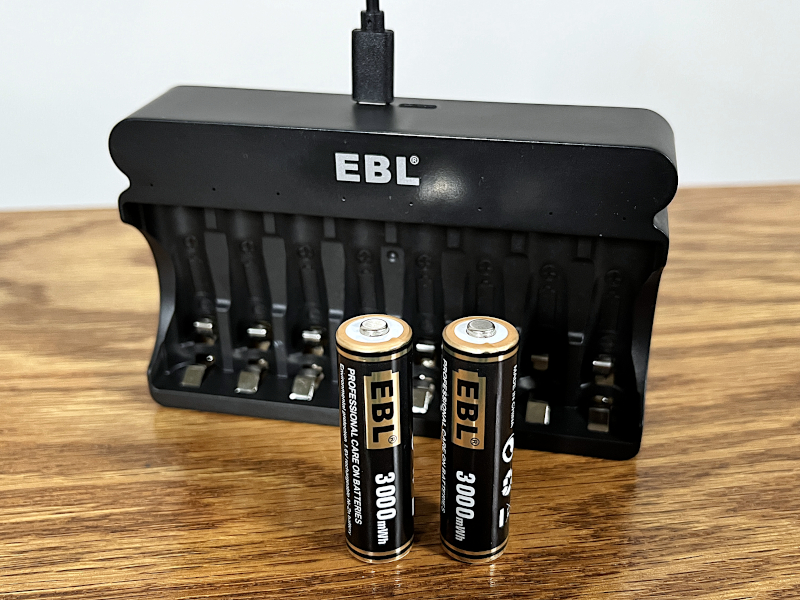
REVIEW – You’re familiar with standard alkaline AA batteries from companies like Duracell, and you are probably familiar with rechargeable NiMH AA batteries, like these from Energizer. They are all the same size (diameter 14.5 mm, length 50.5 mm) and have a standard range for voltage (1.2 to 1.5v), though their capacity can vary widely (typically from 1000 to 2800 mAh). What you may not know is that there are a host of other types of AA batteries that use different materials internally, each having slightly different properties and uses. Today I’m going to be reviewing NiZN AA batteries from EBL.
What is it?
This is a set of 8 rechargeable Nickel-Zinc (NiZN) AA batteries with a charger. They have a 3000 mAh capacity, use 1.6v, and can be recharged 1000 times. EBL has been delivering batteries and chargers for 24 years, and their mission is “to deliver the highest quality and most reliable batteries possible.” They are headquartered in China.
What’s in the box?
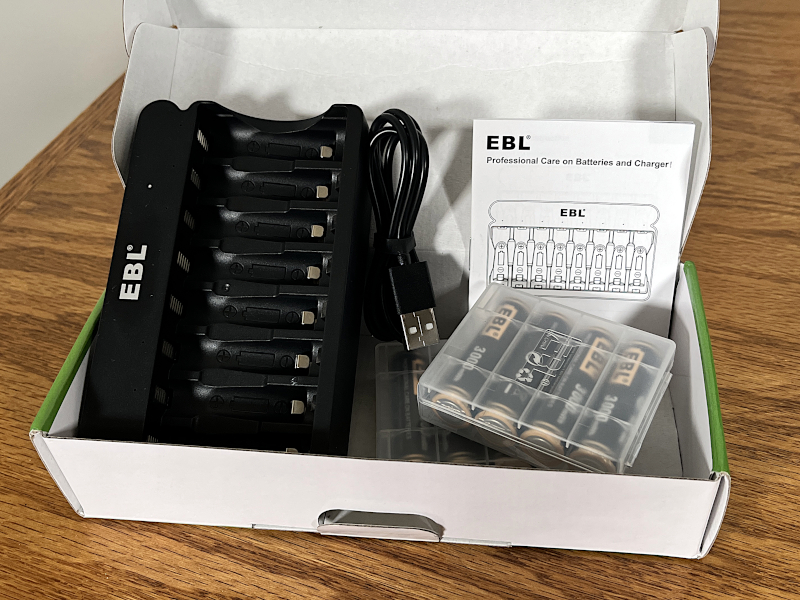
- 8 batteries in 2 plastic cases
- The charger
- A micro USB cable
- User manual (with 4 pages of English instruction)
Hardware specs
The specs of the batteries are:
- Battery Type: NiZN AA
- Voltage: 1.6V
- Capacity: 3000mWh
The specs of the charger are:
- Input: DC 5V/2A
- Output for AA: DC 1.6V 1500mA
- Output for AAA: DC 1.6V 600mA
Design and features
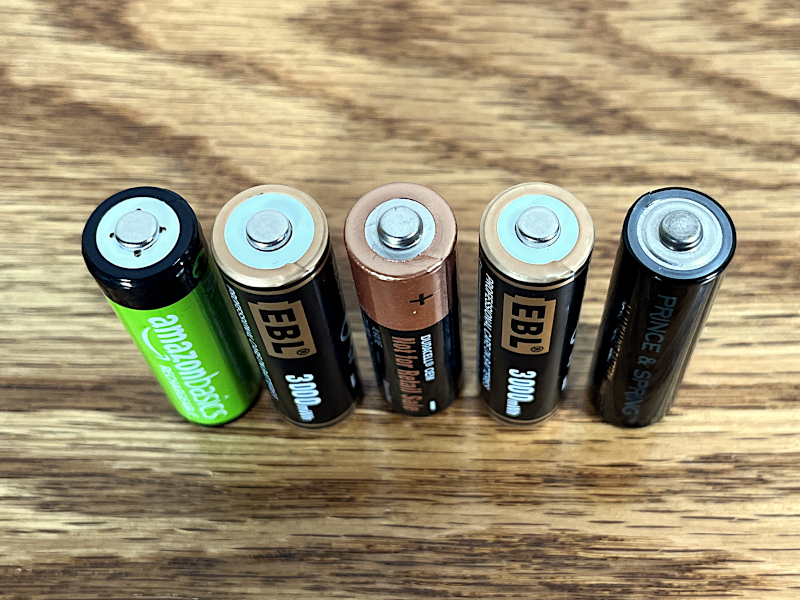
At a glance, these appear to be normal AA batteries with an attractive black and gold design. The size, however, is not the same size as standard AA batteries; the height is identical, but the diameter is slightly wider. Some gadgets have very tight spacing for their batteries, so these NiZN batteries could get stuck if I’m not careful.
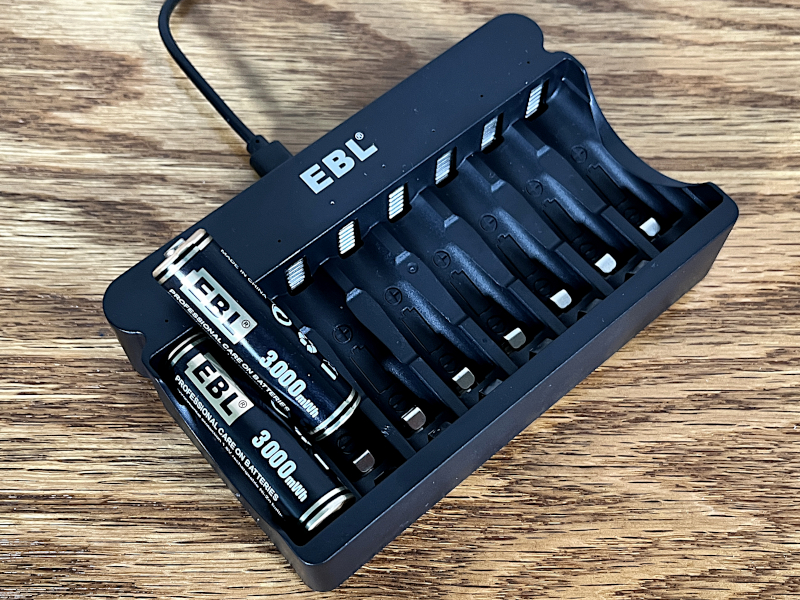
The charger is made of plastic and has a matte black color. It’s a very simple, open-top design that is typical of chargers. The charger can recharge all eight batteries at once, and its size is not much bigger than the batteries themselves. It can also charge AAA NiZN batteries, though none are included in this package.
One word of caution: This charger is only designed for NiZN batteries; don’t use this with other types of batteries, and don’t put NiZN batteries in other types of chargers. I wish the batteries and the charger had a bright warning icon or label to this effect, as I think it will be all too easy for me to forget at some point and make this mistake.
Installation and setup
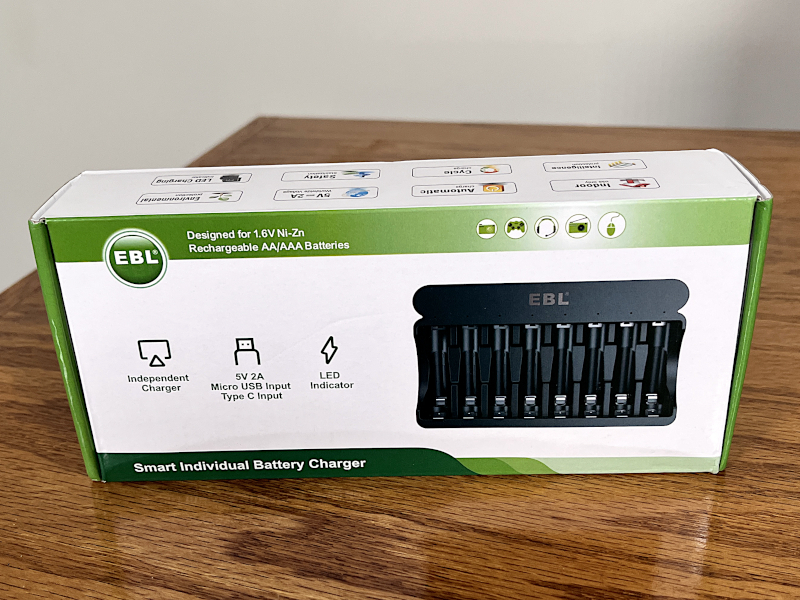
The batteries and charger arrived in a small, cardboard box.
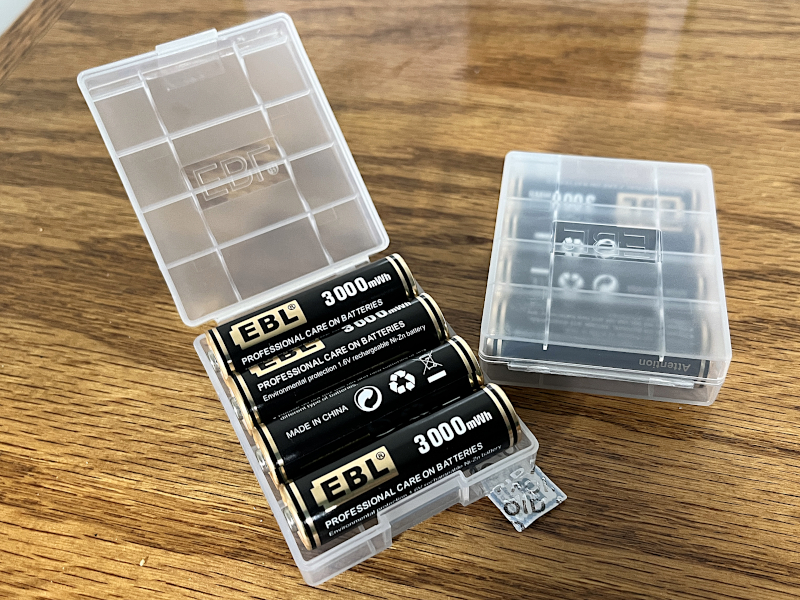
The batteries were in a pair of plastic cases and the charger in bubble wrap; EBL did a good job protecting everything while in transit.
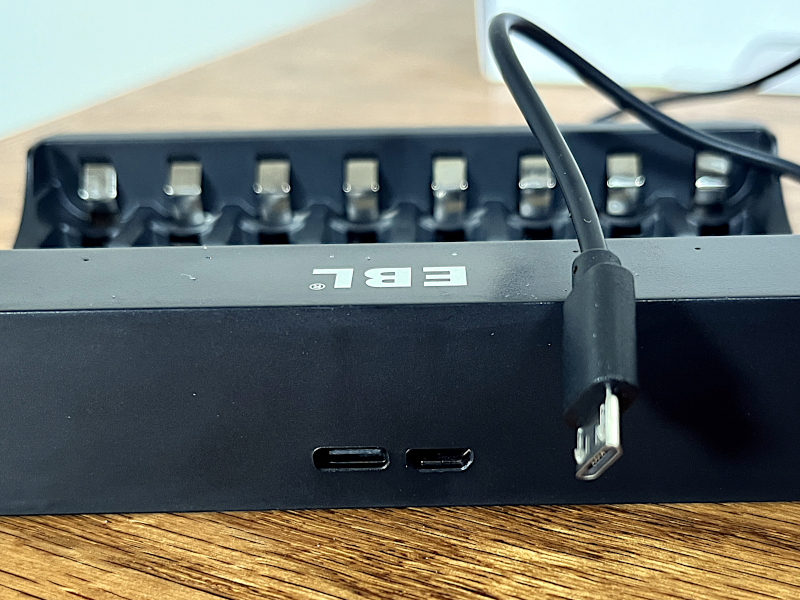
Using this charger could not be any simpler. I opened the plastic cases, removed the batteries, and popped them into position, taking care to put the positive terminal on top. The charger has ports for both USB-C and micro USB. Unfortunately, EBL took a short cut here and only included a micro USB cable, which is quite out of date at this point. I wish that they would drop the micro USB port and include a USB-C to USB-C cable instead.
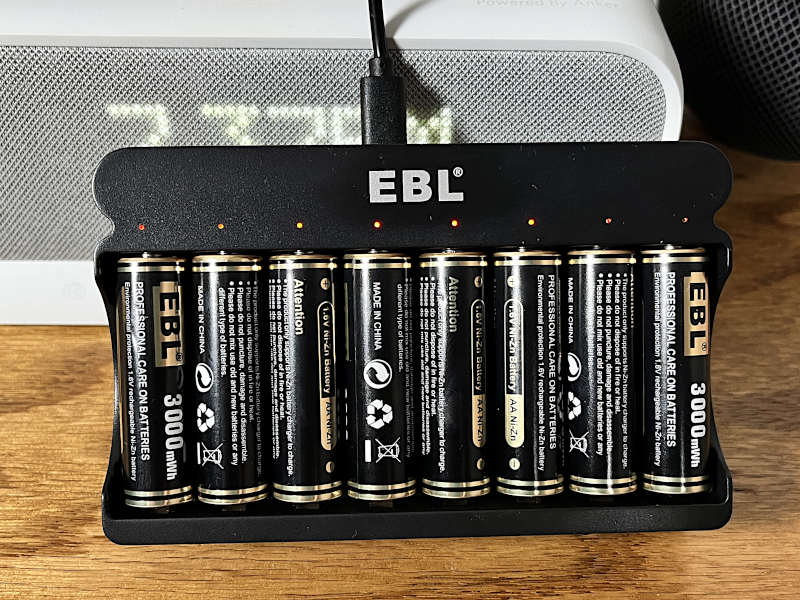
I plugged the USB-A side into my Soundcore Wakey and the micro USB into the top of the charger. While charging, small LEDs above each battery turned red; when finished, they turned green.
Performance
Because these are NiZN batteries, there are a few differences from the alkaline or NiMH batteries that I typically buy. One, it has a nominal voltage of 1.6v, which is higher than normal AAs. When freshly charged, their terminal voltage can be slightly higher, around 1.85v, which can be hazardous to some gadgets. I need to be careful not to use them in any gadget whose circuitry could be sensitive to this higher voltage. Two, these batteries are ideal for high-drain devices, anything that uses a lot of power in a short period of time, like a portable video game player, a radio-controlled toy, or an external camera flash. Three, historically NiZN batteries have not held their charge very well once they’ve been cycled more than 50 times. Time will tell whether this is true of these batteries.
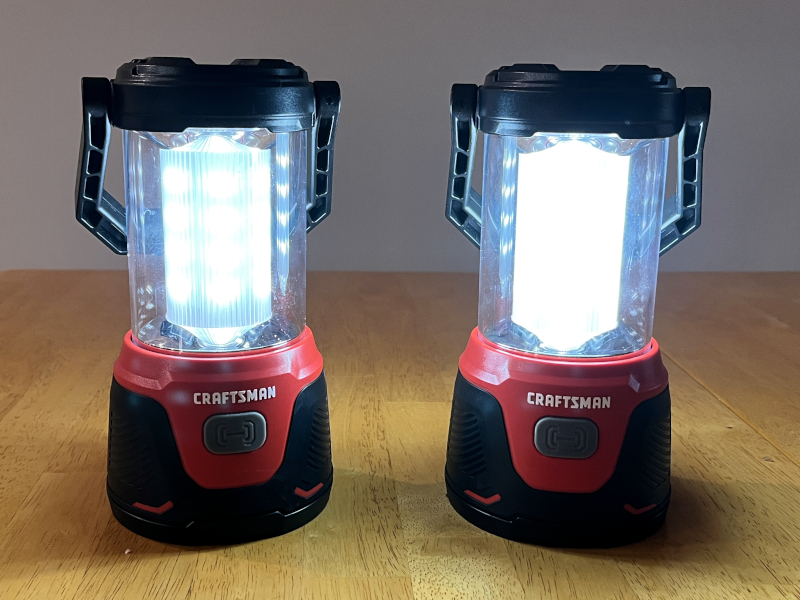
I tested the batteries in two devices. The first device was a pair of Craftsman LED lanterns. They’re designed for camping, but we tend to use them in the backyard while grilling on our Breeo. We often grill after the sun has set, so these lanterns are perfect when we need to check how well done our meat is or to see while eating. Each lantern takes six AA batteries, and on the highest setting can put out 500 lumens, more than bright enough to light up the back porch. When I replaced the alkaline batteries in one lantern with EBL’s NiZN batteries, I could see the difference. At each of the four settings, the lantern with the NiZN batteries was noticeably brighter than the one with alkaline batteries from Duracell. In the photo above, the lantern on the right has the NiZN batteries.

The second device was a Speedlite 430EX II, an external flash for my Canon DSLR camera that uses a set of four AA batteries. When repeatedly shooting flash photography, the batteries in my flash can drain in a hurry. The NiZN batteries had no problem powering the flash, even when firing repeatedly. I can’t tell that the pictures were brighter when compared to alkaline batteries from Duracell, but they worked without any problems. I would be happy to bring a couple sets of four to a photoshoot.
What I like
- Eight batteries
- The ability to charge all eight at once
- Extra power for those gadgets that can use it
What I’d change
- Prominent warnings to avoid using these batteries in other chargers and other batteries in this charger.
Final thoughts
NiZN batteries aren’t for everyone, but if you have a high-drain device, they can provide the power you need. I found that EBL’s batteries did a great job powering my lantern and my Speedlite, and despite their slightly larger diameter, I didn’t have any problems removing them from these gadgets. The charger’s very simple design worked exactly as expected. If you need a mess of NiZN AA’s, then I recommend looking at this gadget from EBL.
Price: $30.29
Where to buy: EBL and Amazon
Source: The sample for this review was provided by EBL.

![[From INIU - the SAFE Fast Chage Pro] Experience the safest charging with over 38 million global users. At INIU, we use only the highest-grade materials, so we do have the confidence to provide an industry-leading 3-Year iNiu Care. [22.5W Speedy Char...](https://m.media-amazon.com/images/I/416nS4GRFtL._SL160_.jpg)

Gadgeteer Comment Policy - Please read before commenting
I wonder how fast it self-discharges while just sitting around. Normal NiMH lose about 1% a day.
From what I read, John, this has historically been a significant problem after an NiZN has been discharged/recharged 50 times (give or take). During testing, I haven’t used them enough to reach this milestone, so I don’t know if that will hold true for these batteries.
As for daily self-discharge, I don’t have a way to measure that. My NiMH charger has a digital display with info that might help, but this charger from EBL doesn’t have that. Ideas on how to measure this?
That sounds like a geeky endeavor where you record charge time for a full charge, let them sit for so many days, then see how long it takes to fully charge again. Even that might not be accurate if the charge rate changes during charging e.g. my FitBit charging slows down when it gets to 90%. Takes forever to get to 100%.
If I’m not mistaken there should be a corresponding voltage drop which you could measure with any off the shelf multimeter.
Just charge them to full, then measure the voltage each day at roughly the same time. A 1% drop might be asking a bit much of an elcheapo multimeter, but a 10% drop over 10 days should be readily apparent. I’m sure there is a formula out there to convert drop in voltage to discharge in Amps.
Good idea, Dav_Daddy, unfortunately I haven’t had a multimeter since my college days.
The increased size is a deal breaker for me. I already have a flashlight which is useless because a self-styled “AA” battery is firmly stuck in it.
Understandable.
I was interested right up until I read the words micro-usb. Yikes…
I’m with you. I’m guessing they wanted to save a buck or two.
Headquartered in China.
No Thanks!
Something, quite literally, does not add up.
First off: battery capacity is normally provided in milliamps hours (mAh). A really top-shelf rechargable AA battery might have something over 2500 mAh. So, seeing 3000 on there batteries really caught my eye. But wait! They actually read 3000 mWh. Milliwatt hour. A watt = volts * amps. So, to return a mWh to a mAh, we have to divide by the voltage. 3000 mWh / 1.6 V = 1875 mAh. Not nearly as impressive.
Second: the charger is rated at 5V 2A. Ok, so multiply. That’s 10 watts. Yet the charger claims to provide 1500 mA @ 1.6 V to the 8 AA battery capacity. So that’s 1500 * 1.6 * 8 = 19.2 watts. See the problem? Most battery charging is applied at a voltage greater than the nominal voltage of the battery (1.6v), so the actual wattage is likely even greater.
I feel like any manufacturer who is playing so fast and loose with their numbers can not possibly be offering a product with high integrity.
This, exactly.
10w divided by 8 batteries at the 1.8v charging voltage comes out at less than 700mA.
Having said that, I own several dozen EBL NiMH AA(2800mAh) and AAA(1100mAh) batteries that I use with an actually decent charger(Youshiko YC5000, which uses a 12v3A supply for 4 batteries. Go figure) , and they are excellent batteries, they all hold roughly the advertised charge, and if they get out of balance or lose capacity, the charger can recover them easily. Occasionally one will discharge to the point where it won’t charge, but the old paperclip trick never fails to bring it back to life.
So, EBL batteries? Great stuff. However I wouldn’t trust this charger as far as I could throw it.
Usually what they’ll do is charge up to a certain number of batteries at full power (about 4 in this case); if you add more batteries, the available input power (10W) will get split between all the batteries… So if we assume 1.8V charge voltage, 10W/1.8V = 5.5A (in a perfect world); 5.5A/8 batteries ~= 694mA per battery. So with 8 depleted batteries slotted, they’d take a little over twice as long to charge than with only 2 or 3.
Using mAh to compare batteries only makes sense if the voltage of the batteries is the same. Energy (mWh) = mAh x Volts. As NiZn batteries have considerably higher voltage than NiMh – 1.6V v 1.2V – they need fewer mAh to store the same amount of energy.
If an NiZn battery holds 3000 mWh that’s the same amount of energy as a 2500 mAh NiMH battery. 1.2V x 2500 mAh = 3000 mWh.
Or in other words, mWh enables comparison of batteries of different voltages.
And here I started to read this story thinking shortly after I will know what “nizn” batteries are… Nope. I mean maybe if I hadn’t gotten bored reading before I gave up. One of the very first things you should have explained was what nizn is… I’m guessing it’s nickel but what’s the other letters stand for? Horrible read
It stands for Nickel-Zinc, which I added to the review.
I would like to know what the actual dimensions are, when you state slightly larger I think if the digital callipers in my tool cabinet that retailed for less than $40 and provide very precise measurements on LCD display. I have considered setting up a standardized test for disposable and rechargeable batteries alike and creating a series of YouTube videos indicating the results of each for comparison and perhaps making a simple calculation tool to determine what the best dolar value is based on brand, type, application and price to assist consumers the deal available for their unique circumstances. Any suggestions would be appreciated, thank you in advance…
I’m sorry, but I don’t have any calipers, digital or otherwise. If you create your comparison, you may want to consider the impact of the higher voltage upon some devices.
Hi there, In order to conduct a meaningful review of an electrical product, especially a rechargeable battery where things like ‘voltage once fully charged’ and ‘voltage loss per day when not in use’ are important factors, then there is a need to provide appropriate information. To state you do not have even a basic multimeter to confirm manufacturers specifications seems odd, and further you state the batteries are larger than normal, yet you say you lack the means to quantify that? As a consumer how can I make any reasonable evaluation of this product given the lack of information provided?